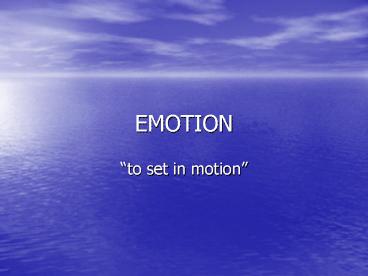EMOTION - PowerPoint PPT Presentation
1 / 21
Title:
EMOTION
Description:
A motivated state marked by physiological arousal, expressive behavior, and ... Different emotions, same state of arousal. Limbic system instead of thalamus ... – PowerPoint PPT presentation
Number of Views:21
Avg rating:3.0/5.0
Title: EMOTION
1
EMOTION
- to set in motion
2
- A motivated state marked by physiological
arousal, expressive behavior, and cognitive
experience. - For examplean angry man
3
THE BIOPSYCHOLOGY OF EMOTION
- THE AUTONOMIC NERVOUS SYSTEM AND EMOTION
- Emotional expression and experience depend on
physiological arousal - Autonomic nervous system
- Fight or flight response
4
- THE BRAIN AND EMOTION
- Limbic system and cerebral hemispheres
- The Limbic system and Emotion
- Hypothalamus
- Control changes in breathing, heart output during
fight or flight - Septum
- Suppresses aversive emotional states
- Amygdala
- React emotionally to different environmental
circumstances - Frontal lobes can inhibit emotional responses
5
- Hemispheric Specialization and Emotion
- Right hemisphere
- Assess emotional states from facial expressions
- Regulating facial expressions
- Negative emotions
- Left hemisphere
- Positive emotions
- Research from Richard Davidson
- Film clips
- 10 month old infants
- Wada test
- Lee, G.P., et. al (1990). Hemispheric
specialization for emotional expression A
reexamination of results from intracarotid
administration of sodium amobarbital. Brain and
Cognition, 12, 267-280.
6
- THE CHEMISTRY OF EMOTION
- Hormones and neurotransmitters
- Hormones and Emotions
- Epinephrine and norepinephrine
- Rise in blood cholesterol
- Endorphins and Emotions
- Pain relief and evoking feelings of pleasure
- Music and naloxone
7
THE EXPRESSION OF EMOTION
- Vocal qualities, body movements and facial
expressions - Look in the face of the person to whom you are
speaking if you wish to know his real sentiments,
for he can command his words more easily than his
countenance. - Peter Jennings and President Reagan
- Women are better than men at recognizing facial
expressions - Survey says
- Out of 19 emotions, women believed to experience
more as opposed to men - More research
- Women perceived to be expressing greater sadness
- Men were perceived to be expressing more anger
- Actors
- Duchenne smile
8
- HEREDITY AND FACIAL EXPRESSIONS
- Expressions evolved because they promoted
survival - Detection of angry and happy faces in a crowd
- Carroll Izard (1990) facial expressions for basic
emotions are inborn and universal - Sugar and quinine
- Chinese infants less expressive than Japanese or
Europeans - Blind children also exhibit emotions
9
- CULTURE AND FACIAL EXPRESSIONS
- Fore tribe of New Guinea
- Told story, then asked to pick a picture
- No contact with westerners
10
THEORIES OF EMOTION
11
BIOPSYCHOLOGICAL THEORIES OF EMOTION
- James-Lange theory, Cannon-Bard theory and
opponent process theory
12
James-Lange Theory of Emotion
- The theory that specific patterns of
physiological arousal changes evoke specific
emotional experiences. - William James and Carl Lange
- Common-sense says, we lose our fortune, are
sorry and weep we meet a bear, are frightened
and run we are insulted by a rival, are angry
and strikethe more rational statement is that we
feel sorry because we cry, angry because we
strike, afraid because we tremble.
13
- Research in support of James-Lange
- Adopt facial expressions
- Measuring physiological responses
- E.T., The Extraterrestrial
14
The Cannon-Bard Theory of Emotion
- The theory that emotion is produced when an event
or object is perceived by the thalamus, which
conveys this information simultaneously to the
cerebral cortex and the skeletal muscles and
autonomic nervous system. - Walter Cannon and Philip Bard
- Different emotions, same state of arousal
- Limbic system instead of thalamus
- Spinal cord injury research in support of
Cannon-Bard
15
The Opponent-Process Theory of Emotion
- The theory that the brain counteracts a strong
positive emotion by evoking an opposite emotional
response - Maintain homeostasis
- Richard Soloman (1980)
- Opposing emotion begins sometime after onset of
the first emotion and lasts longer - If first emotion experienced repeatedly, opposing
emotion grows stronger - Emotion experienced is a compromise between the
two
16
(No Transcript)
17
The Facial-Feedback Theory of Emotion
- The theory that particular facial expressions
induce particular emotional responses - Israel Waynbaum (1907)
- Paul Ekman (1992)
- Sensory neurons convey information from facial
muscles directly to hypothalamus.
18
COGNITIVE THEORIES OF EMOTION
- Two-factor theory and cognitive appraisal theory
19
The Two Factor Theory of Emotion
- The theory that emotional experience is the
outcome of physiological arousal and the
attribution of a cause for that arousal. - Stanley Schachter and Jerome Singer
- Research in support
20
The Cognitive-Appraisal Theory of Emotion
- The theory that ones emotion at a given time
depends on ones interpretation of the situation
one is in. - Richard Lazarus (1993)
- Watched film of a tribal ritual. Incisions made
in an adolescents penises. - Different sound tracks
- Silent group
- Trauma group
- Intellectualization group
- Denial group
- Criticisms
- Thalamus to limbic system bypasses cerebral
cortex
21
(No Transcript)































